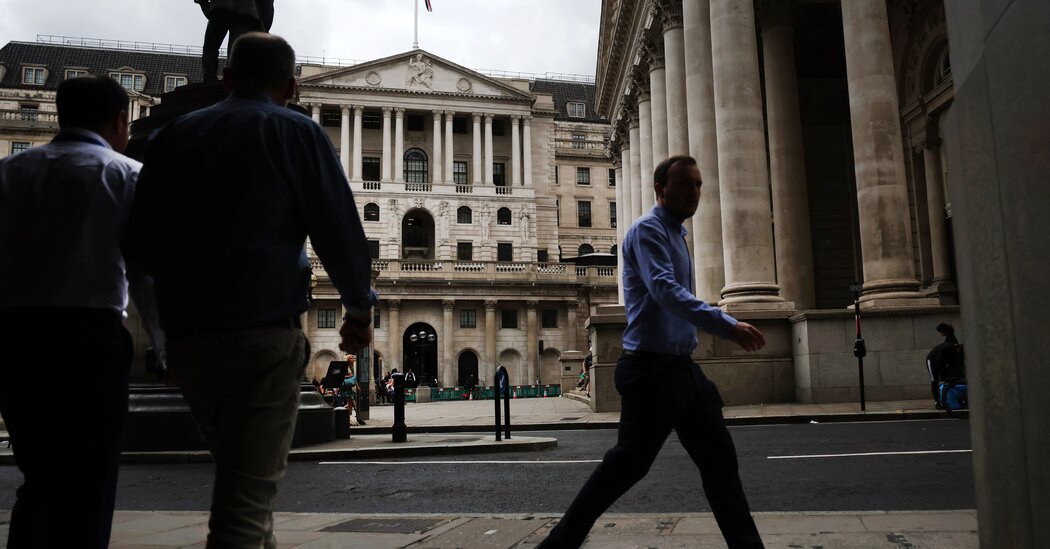The Bank of England left interest rates unchanged on Thursday, the first time in nearly two years that it opted to not raise rates during a long-running battle against stubbornly high inflation.
A day earlier, data showed inflation in Britain had unexpectedly slowed. Policymakers at the central bank kept interest rates at 5.25 percent, the highest since early 2008, pausing after 14 consecutive rate increases. But it was a close-run decision; just five of the bank’s nine rate-setters voted to hold rates.
“Inflation has fallen a lot in recent months, and we think it will continue to do so,” Andrew Bailey, the governor of the central bank, said in a statement. “But there is no room for complacency.” He was among the narrow majority in favor of holding rates steady.
Interest rates need to remain “sufficiently restrictive for sufficiently long” enough to return inflation to the central bank’s 2 percent target, according to the minutes of this week’s policy meeting. Officials also left the door open for further rate increases, “if there were evidence of more persistent inflationary pressures,” the minutes said.
The Bank of England’s pause comes during a long and tumultuous struggle against inflation. The central bank began its cycle of rate increases in December 2021, raising rates from near zero to heights last seen during the financial crisis of 2008. In that time, inflation has soared faster than economists expected and has remained high, even though it is down from its peak of about 11 percent in October.
Policymakers have come under significant public pressure for not maintaining a stronger hold over inflation and not foreseeing the problem in their forecasts. The central bank has said Ben Bernanke, the former U.S. Federal Reserve chair, will lead a review into the bank’s forecasting processes.
This week, some news landed in the central bank’s favor. Consumer prices rose 6.7 percent in August from a year earlier, down slightly from the previous month. Economists had expected the rate to increase because of a global rise in energy prices. Instead, slower food price inflation and other factors pulled the overall rate of inflation down.
Better still for the central bank, measures of domestic inflationary pressures also slowed. The annual rate of core inflation, which strips out energy and food costs that tend to be more volatile and influenced by international markets, fell to 6.2 percent in August, from 6.9 percent the previous month. And services inflation, which is heavily influenced by companies’ wage costs, slowed by more than the central bank’s forecast.
As inflation rates drop across much of the world and economies are weakening, in part because of the aggressive policy tightening by central banks, officials are trying to carefully calibrate the right level of interest rates. Several central banks are shifting their focus from how high to raise interest rates to how long they will need to stay elevated.
On Wednesday, the Federal Reserve left interest rates unchanged, but officials suggested that they expected to make another rate increase before the end of 2023. Last week, policymakers at the European Central Bank said they were likely done raising interest rates, based on their assessment of the economy, and would keep rates at high levels “for a sufficiently long duration.”
Before the Bank of England’s decision was announced, there was an almost-even chance that the central bank would raise or hold rates, according to trading on financial markets. In the end, it was a split decision among the nine members of the central bank’s rate setting committee. The five policymakers who voted to hold rates steady, including Mr. Bailey, cited lower-than-expected inflation rates and signs that the labor market was loosening, with unemployment rising in recent months and fewer job vacancies.
The other four, including the committee’s newest member, Megan Greene, voted to raise rates by a quarter point, arguing that the resilience of the economy, high wage growth and other indicators showed there was evidence of more persistent inflationary pressures.
One of the challenges the Bank of England is facing is the surprising strength of the economy, which has avoided recession as consumers have continued to spend despite rising prices and high interest rates. Recently, Britain’s statistics office said the economy had recovered much more strongly after pandemic lockdowns than it initially estimated.
But as the effects of high interest rates are felt across more of the economy, the outlook is bleaker. The Organization for Economic Cooperation and Development said this week that it expected the British economy to grow 0.3 percent this year, among the slowest of advanced economies, and 0.8 percent next year.
So far, the impact of high interest rates has been felt mostly in the housing sector, where homeowners face jumps in their mortgage payments and housing investment has dropped.
The Bank of England also announced on Thursday that it would continue to sell off its stock of government bonds, acquired since the financial crisis. Over the next year, the bank plans to reduce its bond holdings by 100 billion pounds, or about $123 billion, to £658 billion.










